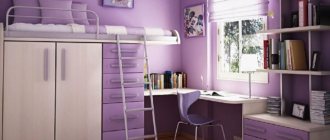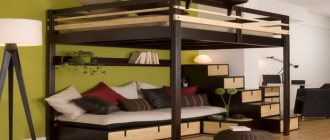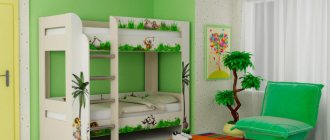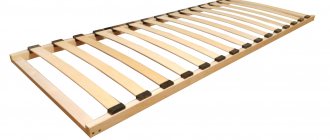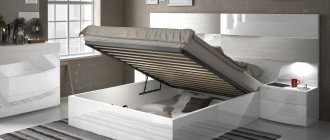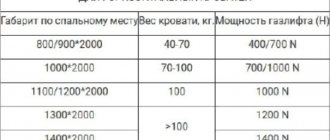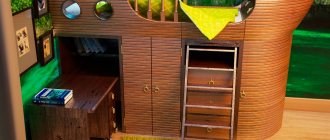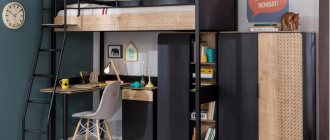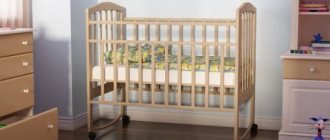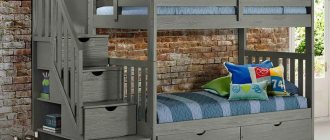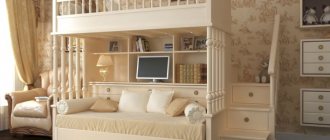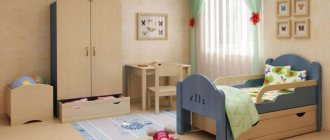Arranging a children's room requires special attention - parents need to create comfortable conditions for children to rest, sleep, play, and study. The choice of sleeping place plays an important role - the child’s healthy, restful sleep depends on its convenience. The optimal solution when equipping children's rooms with furniture would be a bunk bed for teenagers, characterized by compact dimensions, functional content, and interesting design. At the same time, there is enough free space in the room for games, exercise and study.
Positive and negative qualities
The right decision for parents is to place teenagers of the same sex in the same children's room. This simplifies the choice of a bunk bed, but when purchasing furniture, you need to consider whether the product is intended for girls or boys. In order for children to like the sleeping place, you need to take into account their preferences in terms of color, design, execution and functionality of a bunk bed for teenagers . Main advantages of the models:
- compact dimensions - the furniture can be installed in a large or small children's room without taking up extra meters of free space in the room. The dimensions of the sleeping place for teenagers are 1600-2000 mm in length, 800-1000 mm in width;
- functionality, ergonomics - you can choose a model with a built-in wardrobe, table, drawers, sofa, or loft. Additional design elements ensure the ergonomics of the sleeping place;
- strength, stability, long service life. The two-tier model will serve children for many years, providing comfortable and healthy sleep. The strength of the structure guarantees the high quality of the materials used;
- variety of models - among the manufacturers' offers there are ready-made solutions, you can choose custom-made furniture. Based on their shape, there are corner bunk beds for teenagers, transformers, standard models, and roll-out beds;
- the use of high-quality natural materials, finishing products with beautiful and durable fittings. Furniture for children is made from environmentally friendly materials.
There is a wide selection of beds for teenagers, differing in color, design, shape. To make it comfortable for children to sleep and to like the furniture, you need to take into account the tastes of teenagers and invite them to participate in the selection of details.
Bunk beds have important advantages, but these models also have disadvantages. Despite the fact that the furniture is equipped with safety rails, the possibility of a child falling from the upper tier cannot be completely ruled out. To rest on the top bed, the child must climb the stairs and be careful not to hit the steps. Some models are equipped with inclined ladders to make climbing easier.
How to choose the right bunk bed for boys - what to consider
A bunk bed for teenage boys can have any design, the main thing is that it provides children with a restful and healthy sleep.
Before purchasing a product, you need to evaluate the quality of its main elements:
- frame;
- bed bases;
- mattress.
Types of frames
The frame is the basis of the entire structure. Beds with a strong frame are reliable, stable, and can withstand heavy loads.
The stronger the bed frame for boys, the better, because children are restless, so jumping on the bed is not uncommon.
The performance properties of the frame depend on the material from which it is made.
It is better if it is made of wood - an environmentally friendly, safe material of increased strength.
If you want to save money, buy a bed with a metal frame. But this option is more traumatic, so it is not suitable for small children.
It is better to avoid purchasing a structure made from chipboard, MDF or plywood - these are materials that are not very durable and reliable.
If the frame is made of chipboard, MDF or plywood, before purchasing, ask the seller for a certificate of conformity - for safe materials this is E1 and E0. All other options may pose a danger to the child's health.
The decorative finishing of the frame in bunk beds for two boys should satisfy the taste of the children. As a rule, boys prefer an interior that contains strict and clear lines, elements of minimalism and constructivism. It’s good if the shape of the frame is simple.
What should be the sides and stairs - safety requirements
Safety is the most important requirement for an upper bed.
It should be equipped with sides 30-40 cm high to prevent the child from accidentally falling out of the bed. Wooden sides are best - unlike metal ones, they are not cold for the body. Often, children's beds use soft bumpers - upholstered in fabric with a thin lining of padding material.
Make sure that the height of the mattress does not exceed the height of the sides.
Stairs in bunk beds can be of three types:
- classic: suitable for teenagers;
- inclined with railings: for middle-aged children;
- in the form of bedside tables: for kids.
It is better to avoid using ladders made of chromed metal - they are quite slippery.
Types of bed bases, size range and selection rules
The bed base is attached to the frame and is the most important structural element designed to provide proper support to the mattress.
The bases for children's beds can be:
- deaf - in the form of a layer of wood, plywood, MDF or chipboard;
- slatted - consist of many crossbars.
It is better to choose a slatted base - it is also called orthopedic due to its ability to support the mattress in areas of maximum load. In addition, the spaces between the slats allow air to circulate freely in the mattress, removing excess moisture and ensuring hygienic sleep.
The size of the sleeping place should correspond to the height and age of the boys:
- for children under 3 years old: 120x60 cm;
- from 3 to 6 years - 140x70 cm, 150x70 cm;
- from 7 to 14 years – 160x80 cm, 170x80 cm;
- over 14 years old - 180x90, 190x90 cm.
The length of the bed should exceed the child’s height by at least 10-20 cm, and the width should allow him to calmly spread his elbows.
What to consider when choosing a mattress – which ones are there, which ones are better
Mattresses can already be included, but most often they are purchased separately - this allows you to take into account all the needs and health characteristics of the child.
If the boy is healthy, then an anatomical mattress is suitable for him - it is able to follow the shape of the curves of the body, supporting the spine during sleep.
If you have diseases of the spine or musculoskeletal system, it is better to purchase an orthopedic model - it provides enhanced support.
The softness of the mattress should correspond to the age and weight of the boy:
- for children from 0 to 4 years old - a hard mattress;
- from 4 to 7 years – medium hardness;
- 7 – 18 years – hard/medium hard.
A soft mattress is used only if the child is very thin and his body weight is not enough to press the mattress in the right places.
Pay attention to the mattress filling. Ideally, this should be a springless unit or a unit with independent springs.
Spring mattresses are not only short-lived, but also dangerous - a spring that jumps out can rupture the upholstery of the product and injure a child.
Photos of bunk beds for boys in the interior
<
>
If you choose the right type of furniture, its size and design, even the cramped boys’ children’s room with a bunk bed will be transformed - it will become much more spacious and comfortable, which will make it a favorite place to hang out for your children.
Which materials are more practical and reliable?
The main materials for making beds are natural wood, metal, MDF, chipboard, and laminated chipboard. They differ in quality, ease of processing, and durability. In the usual sense, the standard design of a bunk bed is a metal model with two sleeping places on top of each other. But modern products are more interesting, attractive and practical. Advantages and disadvantages of materials:
- natural wood is an environmentally friendly, high-quality material. Wood species are highly durable and look impressive in the interior of children's rooms. The wood lends itself well to processing, has a beautiful texture and pattern. The two-story teenage bed model made of natural wood is characterized by good stability, long service life, and original design. Disadvantages: the structures are massive, can creak, are expensive;
- metal is a reliable, strong, durable material that lends itself well to decorative forging and has a long service life. To connect metal structures, durable fittings are used - bolts, angles, ties, nuts. Powder coating is applied to the metal surface, obtaining a variety of shades. Cons: two-tier metal structures are not suitable for every interior style, there is no filling;
- Wood-based materials (MDF, chipboard) are a common option; a bunk bed with a work area for a teenager is in demand. The plates have the necessary strength and a long service life. The use of chipboard and MDF allows you to implement any design project. Bed models are presented in a rich color palette and have an attractive price. Disadvantage: shorter service life;
- furniture board is a material made from natural wood, made by gluing wooden slats. Thanks to special technologies, high strength of the board is achieved; the material is excellent for making frames, sides, and racks of bunk teenage beds. Manufacturers use furniture panels made of birch, alder, beech, oak, and pine with a beautiful wood texture. The disadvantages of models made from shields include a simpler design.
Less commonly, a combination of plywood and natural wood is used in the production of two-tier beds. The structures are very durable; for reliability, the sleeping bed is reinforced with wooden beams. The design and functionality of products made from wood-laminated boards meet all the requirements for children's furniture. Plywood can be painted in any color and original artistic solutions can be realized.
Ladder and safety requirements
An important structural element of a teenage two-level bed is the staircase. It can be made in the form of a slide with drawers, a fixed vertical structure, or an inclined product. The child needs to climb to the top tier and go down every day, so there are special requirements for the stairs and bed:
- Durable, high quality materials must be used to make the stairs;
- the ladder is securely fixed in the upper and lower planes, additionally secured to the floor depending on the model;
- the steps should not slip; their surface is treated with a wear-resistant coating;
- the staircase is located so that it does not interfere with access to the furniture;
- metal steps are equipped with rubber anti-slip pads;
- roll-out bunk beds for teenagers are equipped with roller mechanisms, wheels, and guides;
- the upper berth must have a fence along its entire length for safety reasons;
- The design of the bed should have as few sharp corners as possible; preference is given to smooth lines.
Bunk beds for teenagers are equipped with three types of stairs. Vertical structures - two longitudinal beams with transverse crossbars, the most compact. Marching stairs are inclined elements with steps and safety railings. Slide stairs and cabinet stairs are the most functional and reliable, they are easy to climb; the space on the steps is used for installing drawers.
An additional condition for the safety of teenage furniture is a durable frame that should well withstand the weight of a sleeping child. You need to pay attention to the width of the model so that teenagers have enough free space to sleep. The optimal height between tiers is at least 1500 mm. If the model is equipped with a working area with a table in the lower part, the distance from the first to the second tier should be from 1600 mm. It is recommended to choose multifunctional children's bunk beds that combine a sleeping area with storage systems, a work or play area.
Types of bunk beds for teenagers
Manufacturers make furniture for one, two or even three children. Relatively speaking, beds for babies can be divided into built-in type and stationary type, straight and corner models. To choose a bed with 2 tiers for teenagers, you need to take into account the dimensions of the room and the recommendations of child psychologists.
Popular types of bunk beds:
- A design with an “attic” for one child is considered a built-in model of furniture, distinguished by a straight or angular shape. It is suitable for a rectangular children's room, as it plays the role of a place for sleeping, entertaining activities, learning and storing your things. If two children live in the room, you can install twin corner or straight beds with a work area below and sleeping places on the second floor.
- A model with 2 sleeping places is considered another variation of a direct children's bed of a built-in or cabinet type. This is a classic version of a bed, the space in the middle of which is used for the perpendicular or parallel location of two similar places to sleep. The second floor here should be given to the eldest child. There are also models of bunk beds with a shifting sleeping area. In this case, space is freed up for installing a wide staircase. Low beds on 2 floors can occupy one of the free corners in the room.
- The corner built-in bed for three children is too comfortable. Sometimes the mother and father of the child can occupy the sleeping places. For example, if furniture was purchased for a one-room apartment. A folding sofa is often inserted on the tier below. In models with transformation mode, you can remove the additional sleeping block from under the lower floor. The pull-out base design allows you to save space after folding the bed. In corner beds, the upper sleeping bed is combined, while another bed is built in and there is a free area for work. The corner furniture option is suitable for four children.
Each type of bunk bed has its own advantages and disadvantages. A two-tier bed has a multifunctional frame and significant cost. Furniture for two children saves space in the room, but has much fewer functional parameters when compared with models for one child. The corner bed for three children has a wonderful design, but takes up significantly more free space than its closest analogues.
Nuances of external design
The central place in a teenager's room is occupied by the bed, so the design should match the style of the room. For children of primary and school age, models made in the form of doll houses, steam locomotives, racing cars, and ships are suitable. But older kids need to choose more mature models.
Recommendations for color schemes for teenage girls' rooms: pastel, cream, pink, light green, white colors with bright accents. Furniture in dark gray, brown, purple, blue, and green looks appropriate in a young man’s room. The emphasis can be placed on sleeping textiles - bright pillows, blankets, bed upholstery. External design of teenage beds:
- traditional style models are made from natural materials. Characterized by a natural and neutral range of shades, a minimum number of decorative elements, a combination of two contrasting colors;
- Rustic-style designs look great in teenage boys’ rooms. The beds are made of durable wood, the presence of massive structural elements is allowed. The wood is unpainted, made in a rough design style;
- beds for teenagers in the Art Nouveau style combine smooth lines and contours, floral motifs, and gentle curves. The products look impressive in girls' rooms. Color palette – cream, beige, milky shades, the presence of figured decor;
- products of innovative style combine practicality, simplicity, functionality, and a minimum of decor. They are distinguished by their original design - a box bed, a corner bunk bed with rounded edges, built-in stairs for teenagers;
- transformers models in minimalist style. The accents are bed textiles in patchwork design. The contours of the product are strict, laconic decoration, restrained range of natural shades.
Girls like beds in bright colors with shaped details and a lot of decorative elements, boys prefer simplicity and functionality. Therefore, it is recommended to choose a bed model together with a teenager.
Psychologists note that color affects a child’s restful sleep; it is important to take into account the tastes and preferences of children when decorating a teenager’s room.
Bunk beds are ideal for furnishing a nursery. The models are distinguished by their compact sizes, the presence of storage systems, and additional elements - a wardrobe, a sofa, an attic. If a teenager sleeps well, is satisfied with the practicality of the furniture, and feels alert and rested in the morning, the bed has been chosen correctly.
